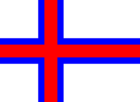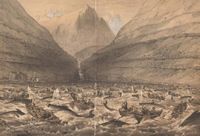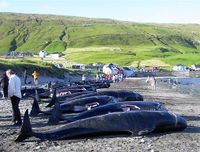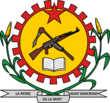Faroe Islands
Føroyar The Middle of Nowhere Faroe Islands | |||||
|---|---|---|---|---|---|
| |||||
| Motto: "Though Iceland is a little bigger than us it doesn't mean that the Icelandic women are better!" | |||||
| Anthem: "Tú Gamla, Tú fría, Tú fjallhøga norð!!" | |||||
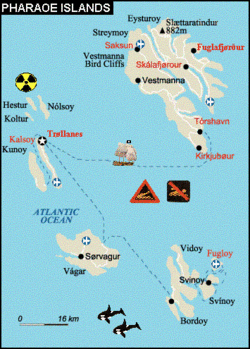 | |||||
| Capital | Tórshavn | ||||
| Largest city | City? | ||||
| Official language(s) | Faroese language and Seagull | ||||
| National Hero(es) | Kaj Leo Johannesen, Trølla Pætur, Dávid Fossdalsá, Líggjas Vang, Heðin Klakstein | ||||
| Currency | Fish | ||||
The Faroe Islands (also known as the Pharaoh Islands or Those Rocks) are a country of rocks and mountains north of Scotland and often mistaken for the Shetland Islands. The Faroes claim Denmark as a territory, a claim so secure that the legislature and the Queen reside there.
The islands are called the Faroes because they were originally a protectorate of Egypt. The Faroes are often spelled "Pharaohs", because no one can spell Faroe without the use of an expensive dictionary. Pundits who would like the islands to continue to confuse despite this workaround assert that it should be written as Phæraoh.
Histøry[edit | edit source]
The first Faroe of the Faroes was Tróndur í Gøtu, whose rule began in the ninth century. He practiced Satanism and strove against Sigmundur Brestisson, a unionist and a newly converted Baptist. Even though the Faroese regard Sigmund as being the good one, he was the evil one, because he brought the Faroese under foreign authority.
Tróndur í Gøtu was a grim man, a really grim man. He was big and bulky and had big red hair. His biggest achievement was the invention of Black Metal, and he built a splendid monument in the shape of a pyramid. The remains of the Great Pyramid can be seen even today, but they are now known as Slættaratindur.
Gøvernment[edit | edit source]
Being a bizarre, overly religious place, the Faroe Islands are a theocratic dictatorship. The current ruler of the islands is Biggason, who has only had two hairstyles in his life, and runs around searching for a higher meaning in life, whilst listening to Britney Spears.
The Faroes are in a continual state of war with Iceland, a nearby island even further toward the middle of nowhere, ruled by evil King Björk.
Ecønømy[edit | edit source]
Wikipedia tells us that, in the 1990s, economic troubles in the Faroes caused unemployment to rise to 10% to 15%. This means that, as has happened in so many other places in the world, all the people stopped wanting work to get done, or failed to find anyone to do it. In addition, the economy of the Faroes is totally dependent on fishing and fish farming. This means that the economy is severely affected, both by the discontinuation of all the fish in the ocean, and by the occasional unanimous decision of the fish to go nowhere near the Faroes, a decision supported by sympathy strikes by fish on farms.
Hopes for economic recovery centre around petroleum discoveries in the vicinity of the Faroes, although the relevant waters are claimed by other nations; also around information technology and other gadgets; perhaps robotics. (Web hosting is out of the question, as the lack of electricity on the islands means that there are no Internet users.) The Parliament plans to adopt the Euro as the national currency, pending a vote that will let politicians claim it was someone else's decision. Entry into the Euro-zone has done wonders for countries like Greece and Italy; namely, putting productive nations on the hook to bail them out.
And, there is now a Burger King in Tórshavn.
Climate[edit | edit source]
The climate is classed as Maritime Subarctic according to the Köppen climate classification: Brr. The islands' climate is influenced by the strong warming influence of the Atlantic Ocean. This means that when the United Nations finally defeats global warming or at least capitalism, there will be no inhabitants of the Faroes except snowmen and ice sculptures.
The islands are windy, cloudy and cool throughout the year with over 260 annual rainy days. Strong winds and heavy rain are possible at all times of the year; sunny days are rare and overcast days are common. However, if the reader was planning a pleasant vacation to the islands, and had perhaps already packed the beach toys and sunscreen, he should not let this information get in the way, as after all, it came from a humour wiki. Hurricane Fatwa struck the Faroe Islands on 5 September 1966. The local weather service did not classify this as a tropical storm system but a carnival ride.
Fløra and fauna[edit | edit source]
The natural vegetation of the Faroes is dominated by species that thrive in chilly, awful weather. Due to the impossibility of cross-pollination with species living on the habitable parts of earth, species have evolved that are unique to the Faroes. They include the Faroe swamp thistle, the Faroe swamp heath, and the Faroe swamp spent soda can. Other species that thrive in treeless wastelands might do well on the Faroes. Only, they can't get there.
The only wild land mammals found on the Faroes were introduced by mankind. These include the wild Faroe mouse, the wild Faroe rat, and the wild Faroe kitty-cat. Like the vegetation, cross-breeding with sensible specimens is impossible. What this says about the local humans is left as an exercise to the reader.
The women of the Faroes are strong, really strong. A single one with a mild headache and a cold can beat up 15 Danes singlehandedly, and twice that number when fresh and rested. The Norse Vikings who inhabited the Faroes were not only some of the best navigators of their time, but they were also nearly made of steel.
The Faroe Islands are notorious as a nesting ground for Psycho Killer Seagulls (and, to a lesser extent, Pigeons). The Killer Seagulls are an evil species with perilous powers, originally bred by Megatron, ruler of the Decepticons, in order to be vessels for his son's arrival on Earth, bringing doom to us all.
Language[edit | edit source]
The language of the Faroes is called Farisee. Like the flora, the fauna, and the women, the decisive aspect of Farisee is the physical impossibility of any cross-pollination. Thus, it is one of several derivatives of Danish that is inscrutable anywhere off the islands. However, Norway, despite being nowhere near the Faroes, tries to imitate it, calling it Norøysk, or Ny norsk.
Things tø dø[edit | edit source]
Klaaksvik is where the Faroe people get water, as it is the only place in the Faroes where it rains. At Klaaksvik there are huge tanks, surely filled with rainwater or something, and all the Faroe people come once every year to celebrate the rain, a celebration called Summarfestivalurin, the day of the year with the most rainfall. (The last four letters of that word are an example of the use of the excretive case of the Farisee language.) A village called Gøta (the name is Spanish for "droplet") has tried to copy this festival, but the townspeople are too lazy to succeed.
However, an activity even more popular than attending the festival is walking along the beach, looking at the ocean, and wishing you were on the other side.
